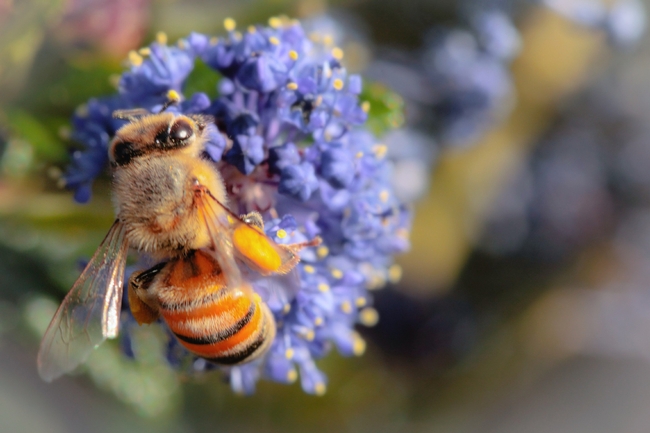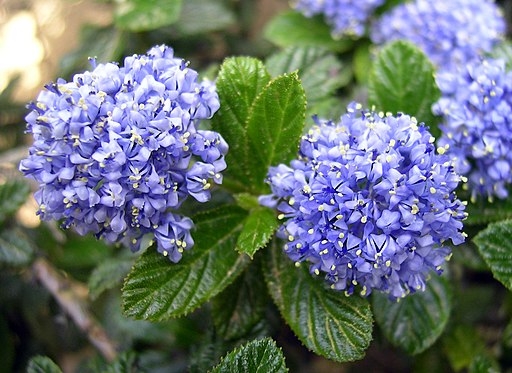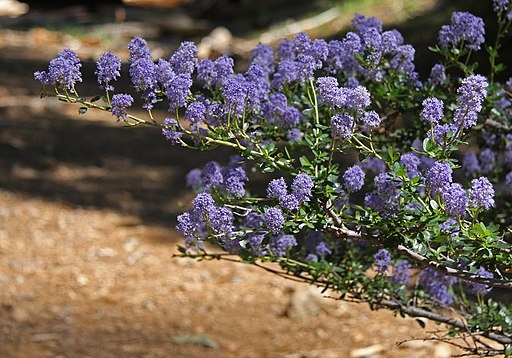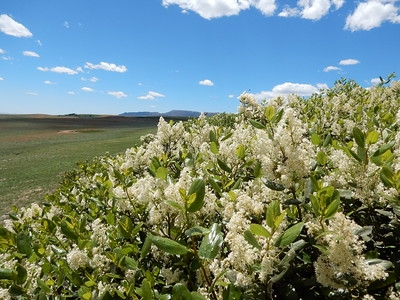By Cindy Watter, UC Master Gardener of Napa County
For me, the great question at the plant nursery these days is whether to buy the little plant or the big one. The small ‘Hot Lips' salvias I bought two years ago are fat and fluffy and covered with flowers today. But when you are on the shady side of seventy, you question the value of deferred gratification. As the White Queen said to Alice in Through The Looking-Glass, "The rule is, jam tomorrow and jam yesterday but never jam today." I recently decided to go for the jam today and bought three 5-gallon ceanothus shrubs.
Of course, the very next day I ran into a UC Master Gardener who reminded me that sometimes the big pots can be rootbound, and the compacted roots will stay that way once planted. Sure enough, one of the ceanothus had the twirlies (roots completely entangled in a circle), so I plunked the decanted plant into a bucket of water to loosen the roots, used my fingers to pull them apart, and spread them out in the hole I dug. That was a few days ago and it seems fine.
My new ceanothus ‘Concha' is a hybrid of a California native plant. There are 46 native ceanothus. These are hardy evergreen shrubs that come in several shapes. Some grow over eight feet tall and some spread like groundcover. Colors vary but blue is the most common. Because of that, the plant's nickname is "California lavender."
Ceanothus requires little care once established. I chose this sun-loving plant because my location is sunny, and the plant is robust enough to challenge aggressive blackberry vine. Ceanothus is pretty and attractive to bees, and its seeds will be food for birds later on.
However, the main reason I am planting ceanothus is because, like most native plants, it needs little water to flourish. It cannot be stated too often: we are in a water crisis. That doesn't mean we are limited to river rocks and succulents in our landscaping. By planting California natives and Mediterranean plants (such as lavender and rosemary), we can have beautiful yards and still save water. A yard full of wildflowers uses only 10 to 20 percent of the water needed to maintain a lawn of the same size.
Ceanothus also improves soil health. It is a nitrogen-fixing plant, meaning it adds nitrogen to the soil. It performs this feat thanks to its symbiotic relationship with Frankia, a benign bacterium that lives in its root nodules.
A plant that attracts bees, provides food for birds, feeds the soil and has low water needs is an excellent plant for the California home landscape. What's not to like?
Planting ceanothus couldn't be easier. Just put it in a hole about twice as wide as the root ball and the same depth. The root crown should be an inch or so above the surrounding soil as it will eventually settle. You don't want your plant to be sunken as it can get waterlogged and maybe even drown.
Because ceanothus is a native, you don't need to amend the soil (with one exception, see below). In fact, it does well in poor soil. While it can go weeks without watering once established, it should have some water the first year.
Put some compost around the base of the ceanothus after planting and cover with much but don't let mulch touch the trunk. Shredded redwood bark—as fine as hair—and rotted leaves are good mulches for this plant, as those materials are found in the wild. The compost and mulch will keep water from evaporating too quickly in the first year.
The first watering of the plant is the most important. Ten gallons is not too much. You want to break down any air holes that might be around the roots.
Greg Rubin and Lucy Warren, authors of The Drought-Defying California Garden, suggest adding mycorrhizal inoculum—a type of fungus—to soil when you plant your ceanothus. "Myco" refers to fungus and "rhiza" to roots. The inoculum stimulates the Frankia to produce nitrogen, and it helps ceanothus succeed in harsh conditions. Many ceanothus already contain the inoculum but you can buy it, too. Follow the package directions.
Once your ceanothus is established it will be easy to care for. In fact, it practically cares for itself and will reward you with the native bees and birds it attracts.
What is the downside to planting a large ceanothus? You have to dig a really big hole. Actually, I had to dig three big holes. I had forgotten the most astonishing bit about getting older: Two years will go by in the blink of an eye, and the smaller plants can surpass the big ones in size by that time. Time's wingèd chariot has its good points.
Workshop: Join the UC Master Gardeners of Napa County for a hands-on workshop on “Garden Pest Management” on Saturday, April 30, from 11 a.m. to 1 p.m.,. at Las Flores Community Center, 4300 Linda Vista Avenue, Napa. Bring gloves and wear gardening attire. Event will be canceled in the event of rain. Registration required or register at
https://bit.ly/3v8a7Y7.
Got Garden Questions? Contact our Help Desk. The team is working remotely so please submit your questions through our diagnosis form, sending any photos to mastergardeners@countyofnapa.org or leave a detailed message at 707- 253-4143. A Master Gardener will get back to you by phone or email. For more information visit https://napamg.ucanr.edu or find us on Facebook or Instagram, UC Master Gardeners of Napa County.
Attached Images:



